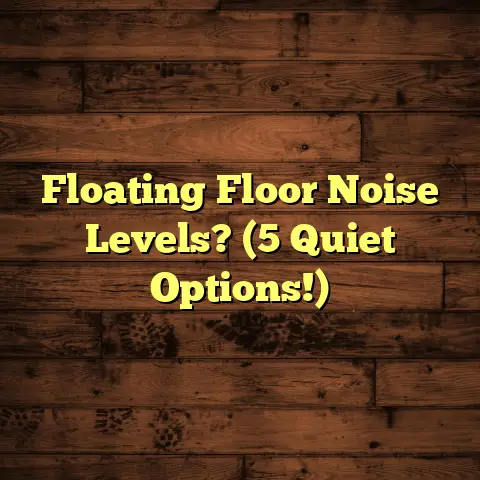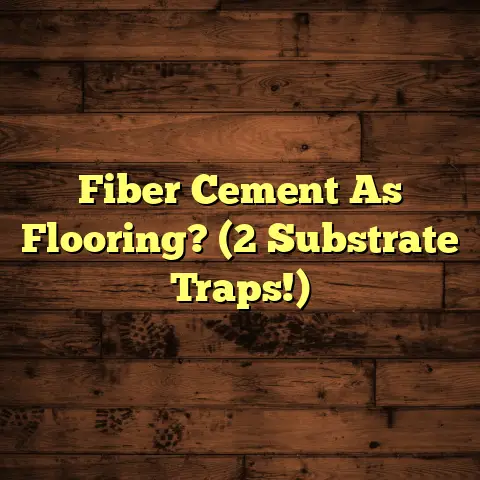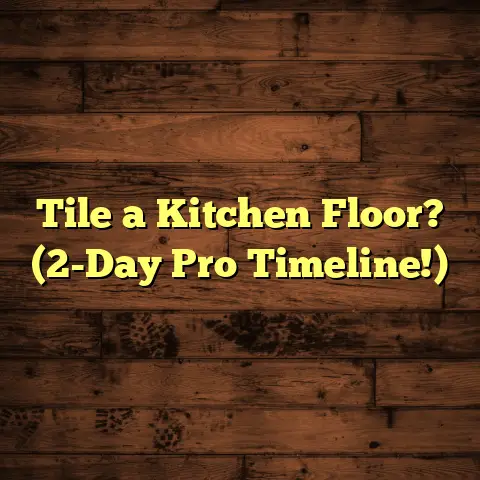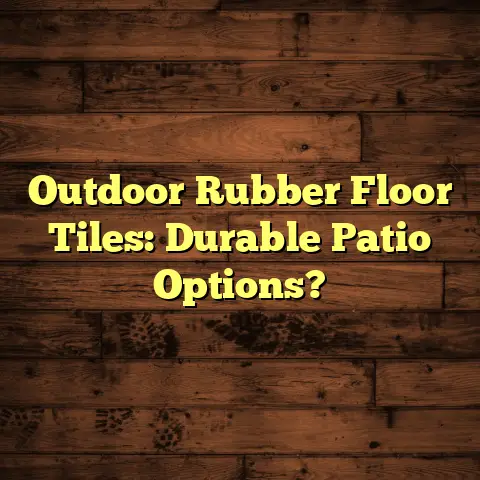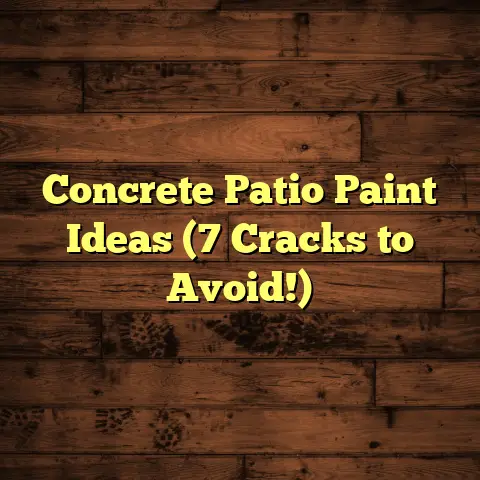Squeaky Floor Fixes? (6 DIY Pro-Level Hacks!)
But seriously, squeaky floors aren’t just annoying. They can be a sign of underlying issues. Think loose boards, moisture problems, or even subfloor damage.
Now, you might be thinking, “Ugh, this sounds like a major headache.” But don’t worry, I’m here to help!
One innovative approach to tackling this issue is through waterproof flooring. Seriously, it’s a game changer, and I’ll tell you why.
In this article, we’ll explore how waterproof flooring can not only boost your home’s durability but also help silence those pesky squeaks.
We’ll then dive into six pro-level DIY hacks that will empower you to tackle squeaky floors head-on.
Ready to reclaim your peace and quiet? Let’s get started!
Section 1: Understanding the Causes of Squeaky Floors
Before we jump into the solutions, let’s get to the root of the problem. What exactly causes those annoying squeaks?
Well, it’s usually one of these culprits:
-
Loose Floorboards: This is the big one. Over time, nails and screws can loosen, causing the boards to rub against each other. It’s often due to the age of the home or improper installation.
-
Moisture Issues: Wood is a natural material, and it reacts to changes in humidity. When it gets humid, wood expands. When it’s dry, it shrinks. This constant movement can cause friction and, you guessed it, squeaks!
-
Nail and Fastener Problems: Rusting or loosening of nails and screws can lead to movement and noise. I’ve seen some seriously corroded fasteners in my day!
-
Subfloor Issues: The subfloor is the foundation beneath your flooring. If it’s uneven, damaged, or poorly installed, it can cause instability, leading to squeaks.
Section 2: The Benefits of Waterproof Flooring Options
Okay, now let’s talk about how waterproof flooring can be a total game-changer when it comes to squeaky floors.
Think about it: a lot of squeaks are caused by moisture. So, if you can eliminate the moisture problem, you can eliminate a lot of the squeaks!
Here are some waterproof flooring options to consider:
-
Vinyl Flooring: This stuff is tough. It’s super durable, easy to install (DIY-friendly!), and completely resistant to moisture. Plus, it comes in a ton of different styles and patterns.
-
Laminate Flooring: Laminate is a more affordable option, and it looks great too. Many laminate floors now come in waterproof variants, making them a great choice for kitchens and bathrooms.
-
Tile Flooring: Tile is the king of waterproofing. It’s incredibly robust, easy to clean, and completely resistant to water damage. Perfect for bathrooms, laundry rooms, and even kitchens!
-
Engineered Wood: Want the look of real wood without the moisture worries? Engineered wood is your answer. It’s made with layers of wood that are bonded together, making it more stable and less prone to warping than traditional hardwood.
How do these materials prevent moisture-related squeaks? Well, they don’t absorb water, so they don’t swell or shrink with changes in humidity. This means less friction and fewer squeaks!
Section 3: Pro-Level Hack #1: The Powder Trick
Alright, let’s dive into our first DIY hack! This one’s super simple, but surprisingly effective. It’s the powder trick!
Basically, you’re using talcum powder or graphite to silence squeaks by lubricating the areas where the floorboards are rubbing together.
Here’s how to do it:
-
Identify the Squeaky Boards: Walk around your floor and pinpoint exactly where the squeaks are coming from. Mark those spots with a pencil or some painter’s tape.
-
Apply the Powder: Sprinkle a generous amount of talcum powder or graphite powder onto the squeaky area.
-
Work it In: Use a soft brush or cloth to work the powder into the cracks between the boards. You want to make sure it gets down into those friction points.
-
Clean Up: Wipe away any excess powder with a damp cloth.
Why does this work? The powder acts as a lubricant, reducing friction between the boards. It’s a temporary fix, but it can be a lifesaver in a pinch!
Section 4: Pro-Level Hack #2: The Screw Method
Okay, now let’s move on to a more reliable technique: the screw method!
This involves reinforcing loose floorboards by driving screws into them. It’s a bit more involved than the powder trick, but it’s much more likely to solve the problem long-term.
Here’s a step-by-step guide:
-
Identify the Squeaky Boards: Again, you need to pinpoint the exact location of the squeaks.
-
Locate the Floor Joists: You need to screw the floorboards into the joists below for maximum stability. Use a stud finder to locate the joists.
-
Pre-Drill Pilot Holes: This is crucial! Pre-drilling prevents the wood from splitting. Use a drill bit that’s slightly smaller than the diameter of your screws.
-
Drive in the Screws: Use wood screws that are long enough to penetrate the floorboards and go at least an inch into the joists. Drive the screws in at a slight angle for extra holding power.
-
Countersink the Screws: You don’t want the screw heads sticking up! Use a countersinking drill bit to create a small recess for the screw heads.
-
Fill the Holes (Optional): If you want a seamless look, you can fill the screw holes with wood filler. Sand it smooth and then stain or paint to match your flooring.
Safety Precautions:
- Wear safety glasses to protect your eyes from flying debris.
- Be careful not to drill or screw into any electrical wiring or plumbing.
Section 5: Pro-Level Hack #3: The Wood Block Method
Ready for a more advanced technique? Let’s talk about the wood block method!
This involves using wood blocks to stabilize squeaky boards from underneath. It’s a bit more work, but it’s a great solution for squeaks that are caused by a gap between the floorboards and the subfloor.
Here’s how to do it:
-
Access the Underside of the Floor: This is the trickiest part. You’ll need to access the floor from below, either through a basement or crawl space.
-
Locate the Squeaky Area: Have someone walk on the floor above while you’re underneath to pinpoint the exact location of the squeak.
-
Measure the Gap: Use a measuring tape to measure the gap between the floorboard and the subfloor.
-
Cut the Wood Blocks: Cut wood blocks that are slightly larger than the gap you measured. You can use scrap wood for this.
-
Apply Construction Adhesive: Apply a generous amount of construction adhesive to one side of the wood block.
-
Position and Secure the Block: Position the wood block under the squeaky floorboard and press it firmly against the subfloor. You may need to use a clamp to hold it in place while the adhesive dries.
-
Let the Adhesive Dry: Allow the adhesive to dry completely according to the manufacturer’s instructions.
Tips for Ensuring Proper Security:
- Use high-quality construction adhesive.
- Make sure the wood blocks are snug and secure.
- Use multiple blocks if needed to stabilize a larger
area.
Section 6: Pro-Level Hack #4: The Adhesive Method
Now, let’s talk about using construction adhesive to bond loose floorboards to the subfloor.
This is a great option for squeaks that are caused by the floorboards separating from the subfloor.
Here’s a detailed application guide:
-
Identify the Squeaky Area: As always, pinpoint the exact location of the squeak.
-
Drill Pilot Holes: Drill small pilot holes through the floorboard and into the subfloor. This will allow the adhesive to penetrate and create a strong bond.
-
Apply Construction Adhesive: Use a caulking gun to apply construction adhesive into the pilot holes.
-
Weigh Down the Floorboard: Place a heavy object on the floorboard to press it firmly against the subfloor.
-
Let the Adhesive Dry: Allow the adhesive to dry completely according to the manufacturer’s instructions.
-
Remove the Weight: Once the adhesive is dry, remove the weight.
-
Fill the Holes (Optional): If you want a seamless look, you can fill the pilot holes with wood filler. Sand it smooth and then stain or paint to match your flooring.
What types of adhesive are suitable for different flooring types?
- Wood Floors: Use a wood-specific construction adhesive.
- Laminate Floors: Use a laminate-specific construction adhesive.
- Vinyl Floors: Use a vinyl-specific construction adhesive.
- Tile Floors: Use a tile-specific construction adhesive.
Section 7: Pro-Level Hack #5: The Shim Technique
Shimming is another effective way to reduce squeaks, especially when you’re dealing with uneven subfloors.
This involves using shims to fill gaps and stabilize loose boards.
Here’s how to use shims effectively:
-
Access the Underside of the Floor: Again, you’ll need to access the floor from below.
-
Locate the Gap: Have someone walk on the floor above while you’re underneath to pinpoint the exact location of the gap.
-
Insert the Shims: Insert shims into the gap between the floorboard and the subfloor.
-
Test the Floor: Have someone walk on the floor above to see if the squeak is gone.
-
Trim the Shims: Once you’re satisfied that the shims have eliminated the squeak, trim off any excess shim material with a utility knife.
What are the right materials for the best results?
- Wood Shims: These are the most common type of shim and are great for filling larger gaps.
- Plastic Shims: These are more durable than wood shims and are great for filling smaller gaps.
Section 8: Pro-Level Hack #6: The Caulk Solution
Lastly, let’s explore how caulking can be used to fill gaps that cause squeaks.
This is a great option for squeaks that are caused by small gaps between the floorboards and the baseboards or walls.
Here’s how to apply caulk correctly:
-
Clean the Area: Clean the area around the gap with a damp cloth.
-
Apply the Caulk: Use a caulking gun to apply a bead of caulk along the gap.
-
Smooth the Caulk: Use your finger or a caulking tool to smooth the caulk.
-
Let the Caulk Dry: Allow the caulk to dry completely according to the manufacturer’s instructions.
What types of caulk are available?
- Acrylic Caulk: This is the most common type of caulk and is great for general-purpose use.
- Silicone Caulk: This is more durable than acrylic caulk and is great for areas that are exposed to moisture.
What are the long-term benefits in preventing future squeaks? Caulking helps to seal the gaps and prevent moisture from getting in, which can help to prevent future squeaks.
Conclusion: Embracing DIY Flooring Solutions
So, there you have it! Six pro-level DIY hacks to tackle those annoying squeaky floors.
Remember, addressing squeaky floors isn’t just about peace of mind. It’s also about preserving the integrity of your home.
By taking control and resolving these issues yourself, you can ensure a quieter, more comfortable living environment.
And don’t forget about the power of waterproof flooring options! By considering these materials, you can preemptively tackle the root causes of squeaks while enjoying the aesthetic and functional benefits of modern flooring.
Now go forth and conquer those squeaks! You got this!
